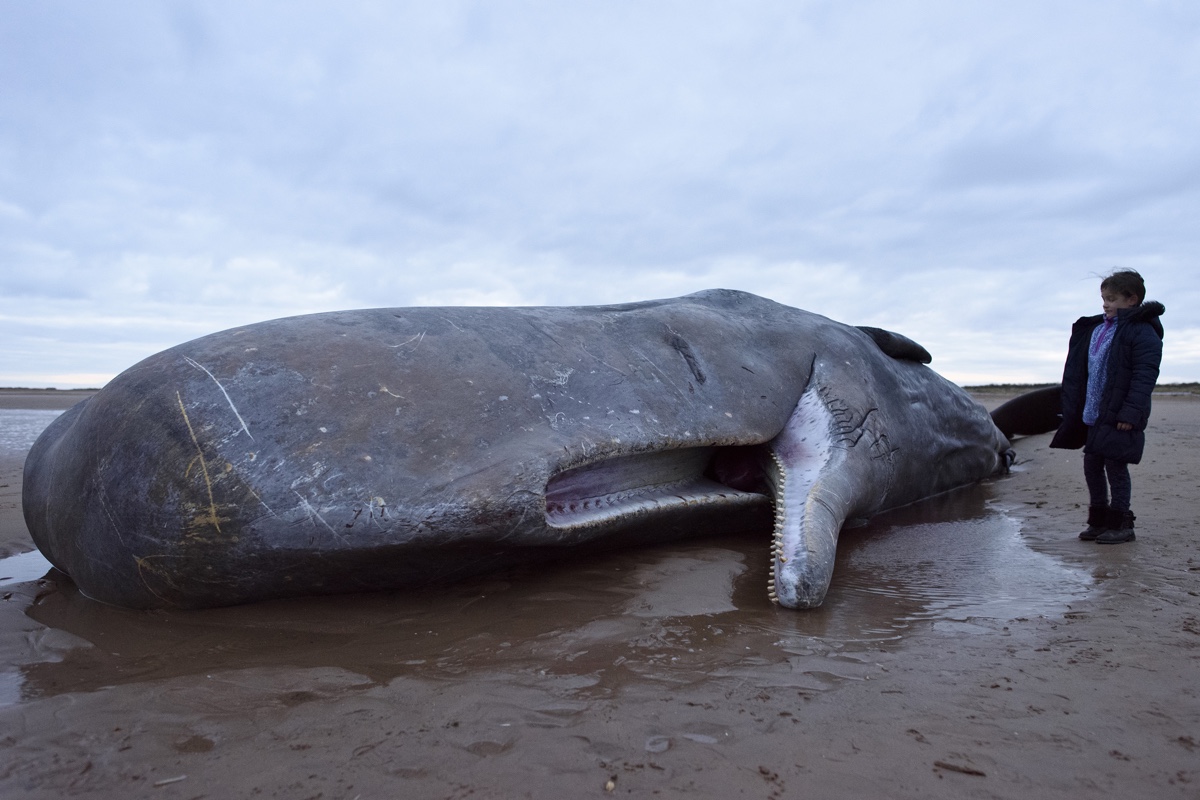Solar Flares May Explain Mass Whale Stranding

A solar storm currently affecting the Earth's high atmosphere could spell bad news for an unexpected victim: whales.
Recent research finds that the fatal stranding of 29 whales in early 2016 could have been caused by solar activity — when mind-boggling amounts of energy erupt from the sun in various forms. Magnetic waves emanating from solar storms may affect sperm-whale navigation, that study found. The navigational confusion can be deadly if whales end up swimming into too-shallow waters and getting stuck.
Just this month, on Sept. 4, one type of solar storm, called a coronal mass ejection (CME), erupted from the sun, according to the National Space Weather Prediction Center. CMEs fling charged plasma and magnetic fields from the sun's surface toward Earth, where they cause fluctuations in the planet's magnetic field. Migratory animals like sperm whales, birds and sea turtles all use the geomagnetic field to navigate. [See Photos of Whales and Sharks from Above]
Sperm whale strandings
The possible culprit for last year's sperm whale stranding seems to have occurred around the period of Jan. 8 to Feb. 4, 2016, when 29 male sperm whales (Physeter microcephalus) were found dead or dying on the shores of Germany, France, Great Britain and the Netherlands. Autopsies on 22 of the whales revealed that the animals were well-nourished and had no signs of illness, according to the new research paper published in the International Journal of Astrobiology.
With no other explanation for what might have caused the whales to become stranded, researchers wondered if scrambled navigation systems might be to blame. No one knows exactly how sperm whales use geomagnetic fields to navigate. But the animals may take into account the natural gradient in the Earth's magnetic field from pole to equator as well as the directionality of the magnetic fields, Klaus Heinrich Vanselow of Kiel University in Germany and colleagues wrote in the new paper.
Vanselow and his colleagues collected magnetometer data from the region of the whale stranding from the Norwegian Sea in the North Atlantic Ocean south to the Azores (a group of islands off the coast of Portugal). The researchers found that two solar storms (one occurring from Dec. 20 to 21, 2015, and one from Dec. 31, 2015 to Jan. 1, 2016) altered local geomagnetic fields.
At Solund, Norway, the researchers found, the intensity of the magnetic field changed from 51,150 nanoteslas (nT) to 51,450 nT, and then down to 50,520 nT. That was a change of more than 900 nT in about 18 hours, or about the same gradient change a whale might experience while swimming the 286 miles (460 kilometers) from Shetland to Norway, the researchers wrote.
Get the Space.com Newsletter
Breaking space news, the latest updates on rocket launches, skywatching events and more!
The second solar storm caused a local intensity increase of 230 nT, followed by a decrease of 310 nT, changes similar to those experienced across a 172-mile (277 km) north-to-south journey for a sperm whale. On top of the intensity changes, the solar storms also changed the directionality of the local magnetic fields. Those changes could have thrown the whales' navigation systems off by as much as 186 miles (300 km), the researchers reported.
Tragic outcomes
In the open ocean, sperm whales can probably compensate for temporary disruptions to their magnetic navigation, Vanselow and his colleagues wrote. Additionally, solar storms have less impact on the geomagnetic field at low latitudes, where sperm whales are born and where females spend their entire lives. But after weaning, young males travel to northern waters, lured west of the British Isles and into the Norwegian Sea by ample meals of squid.
The whales don't typically venture into the North Sea (a body of water south of Norway and north of the Netherlands), the site of the 2016 stranding, but the magnetic field anomalies described in the new paper could easily confuse the animals, the researchers wrote. If an increase in magnetic field intensity fools the whales into thinking they're farther north than they are, for example, they might overcorrect by swimming too far south.
In the shallow, near-shore environments of the North Sea near the stranding, whales may be unable to turn around and swim back the way they came, with fatal results, the researchers concluded.
Years can pass without whale strandings occurring in the North Sea, even when the sun is active. One 2007 study found that strandings are slightly correlated with water temperatures, which suggests that perhaps prey availability and shifts in the whales' feeding grounds play a role in whether whales are vulnerable to stranding, the researchers wrote.
Original article on Live Science.
Join our Space Forums to keep talking space on the latest missions, night sky and more! And if you have a news tip, correction or comment, let us know at: community@space.com.

Stephanie Pappas is a contributing writer for Space.com sister site Live Science, covering topics ranging from geoscience to archaeology to the human brain and behavior. She was previously a senior writer for Live Science but is now a freelancer based in Denver, Colorado, and regularly contributes to Scientific American and The Monitor, the monthly magazine of the American Psychological Association. Stephanie received a bachelor's degree in psychology from the University of South Carolina and a graduate certificate in science communication from the University of California, Santa Cruz.










